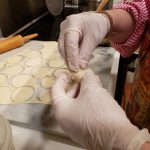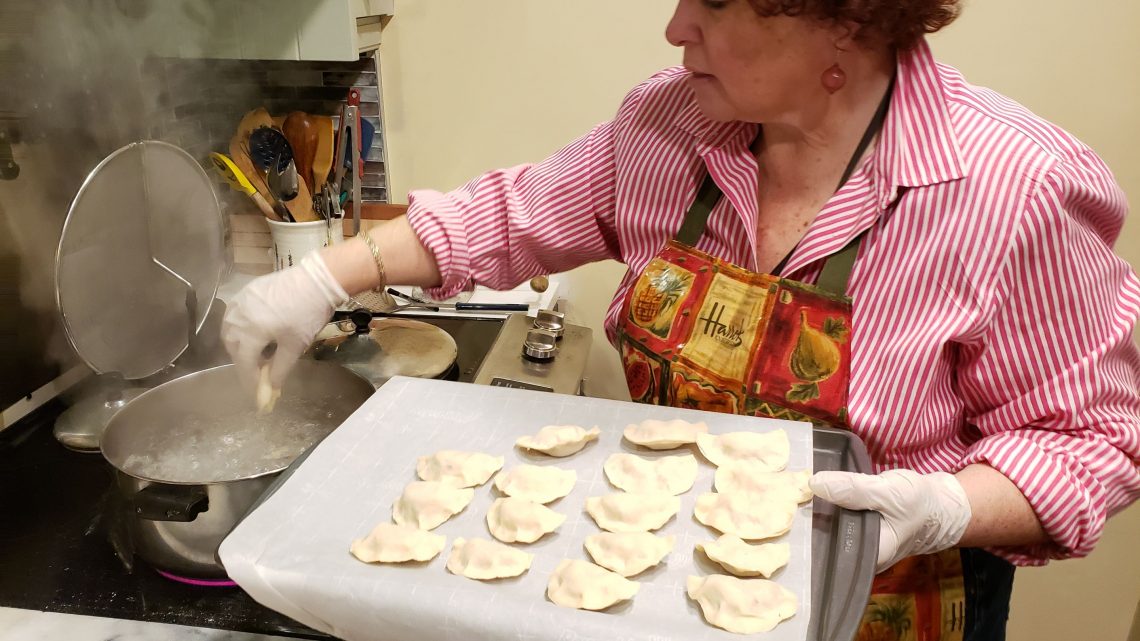 With dexterous fingers, Basia Hirsh filled and folded delicate rounds of dough into Polish pierogi. It was a long-standing tradition in her family but a skill she had only recently learned from her Mother.
With dexterous fingers, Basia Hirsh filled and folded delicate rounds of dough into Polish pierogi. It was a long-standing tradition in her family but a skill she had only recently learned from her Mother.
Beloved traditional foods are key parts of important celebrations across all cultures: turkey for Thanksgiving; cookies for Christmas; and latkes for Hanukkah are just a few that come to mind at this time of year.
In Poland and across central and eastern Europe pierogi – filled dumplings – are the must-have dish for Christmas Eve. They call up memories of past gatherings as they are eaten year after year.
 There are infinite variations from region to region, town to town and family to family. Like chocolate chip cookies, there is no one right recipe, but everyone has a favorite.
There are infinite variations from region to region, town to town and family to family. Like chocolate chip cookies, there is no one right recipe, but everyone has a favorite.
When I asked my neighbors Karol and Marek (first-generation Poles) about perogies, their faces lit up. “There’s no Christmas without pierogi,” they told me.
Basia makes the Ruski-style potato and farmer cheese filled pierogi, named for the Ruthenian region of Ukraine, once a part of Poland. Others she fills with a mixture of Polish sauerkraut, onion and dried porcini mushrooms. Just a couple inches across, the pierogi are smaller than those from other regions. Only meatless Pierogi are eaten on Christmas Eve.
Pierogi are made at home, usually by an experienced matriarch – mother or grandmother. Near the end of her life, Basia’s mother brought her into the kitchen to pass along her knowledge. “A little of this, a little of that, there you have it, now you know,” is what her mother told her.
With no written recipe and that basic teaching (and an internet assist), Basia has taken up the mantle of pierogi maker. Marsha and I were invited to her house overlooking Lake Candlewood to watch and help.
The fillings were prepared in advance. Riced boiled potatoes, caramelized onions and Twarog farmer’s cheese were mixed by hand. A blend of imported sauerkraut, sautéed onions and dried porcini mushrooms were tossed together.
 “It’s all peasant food,” Basia pointed out. Simple and delicious.
“It’s all peasant food,” Basia pointed out. Simple and delicious.
Basia made an uncomplicated dough of heated-to-steaming butter and water, flour and salt. Rolled out to a uniformly thin sheet – a tricky business – it was cut into two inch circles.
Now comes the hard part.
The circles are stretched a little more, dabbed with a mound of filling, and folded in half. The dumplings should be plump but not overfull. The edges are crimped together, each person’s edge as individual as a fingerprint. It sounds easy, but take it from me, it’s pretty challenging for the first few dozen.
These pierogi were to be frozen (the batch makes a lot) for Christmas Eve, but a few of each type were plunged in boiling water to feed us cooks. Simmer one minute more after they float, was the advice from Basia’s mother. Served hot with sour cream, they were delicate and delicious.
Making the pierogi is a pleasure, but ready-made pierogi are available too. Karol and Marek mentioned a lady in Stamford who makes excellent ones out of her house, but the details were not forthcoming – keeping the secret, I think.
They also recommended the Polish Delicatessen at 274 Connecticut Avenue in Norwalk as a source for Christmas pierogi. With a large Polish population, Connecticut is blessed with numerous Polish restaurants and delicatessens offering pierogi or ingredients.
Like turkey and stuffing on Thanksgiving, pierogi are valued as leftovers. The next day, cooked pierogi are sautéed in butter till brown and crisp and served with buttery caramelized onions on top. Unused filling is folded into a crêpe (like a blintz) and browned in butter to make naleśniki.
Pierogi are enjoyed year-round in Poland, but they’re an essential item on the Christmas Eve dinner menu.
As work finished, Marsha said, “I’m feeling good about my pierogi skills. Can we do this again next year?”
Frank Whitman can be reached at NotBreadAloneFW@gmail.com.














No Comment